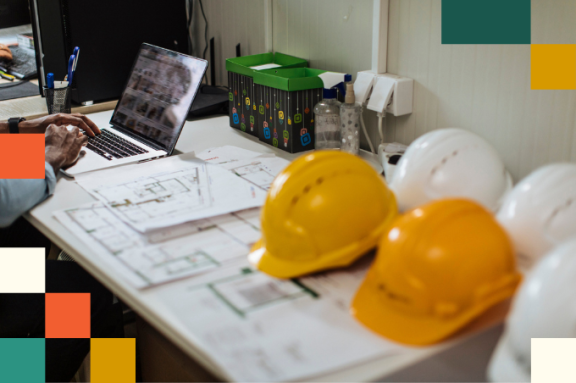
When it comes to construction projects, safety isn’t just a priority—it’s the backbone of everything. Construction is a high-risk industry, featuring heavy machinery, complex work environments and workers operating sometimes in high-risk areas (heights, underground, etc.), meaning there’s always something that could go wrong. That’s where construction safety management steps in, ensuring workers stay safe, projects run smoothly, and companies stay compliant with safety regulations.
In this blog, we’ll break down what construction safety management really means, why it’s so crucial, and how you can implement it effectively to safeguard your projects and your people. Ready? Let’s dive in!
What Is Construction Safety Management?
Construction safety management is a fancy way of saying “let’s keep everyone safe on the job site.” It’s all about identifying potential risks, setting up protocols to manage them, and making sure everyone knows the drill. It falls under the broader environment, health, and safety (EHS) system. Think of it as creating a playbook for safety.
This involves everything from developing safety guidelines and training programs to ensuring compliance with regulations (OSHA) and fostering a culture where safety is second nature.
Why Is Safety Management So Important?
Here’s the deal: safety isn’t only about avoiding accidents—it’s also good for business. According to a SmartMarket report, companies with strong safety programs reported:
- 4.2% improvement in project timelines
- 4.4% improvement in budgets
That’s not all. Over two-thirds of contractors noticed better project outcomes overall. Let’s break it down further:
- Fewer accidents mean fewer disruptions, lower insurance costs, and happier employees.
- Clients trust companies with a stellar safety record, so you’re more likely to land those lucrative contracts.
- A safer worksite equals a more productive team, which means projects get done faster and more efficiently.
Benefits of Construction Safety Management
Here are the standout benefits of nailing safety management:
- Reduced Accidents and Injuries
- Better Project Efficiency
- Enhanced Reputation
Key Components of a Rock-Solid Safety Management Program
So, how do you create a safety management program that works? Here are the essentials:
1. Safety Planning and Risk Assessment
Before the first hammer swings, identify potential hazards and figure out how to handle them. Think ahead to stay ahead.
2. Training and Education
Safety isn’t instinctive—it’s taught. Regular training sessions ensure everyone knows the rules and how to handle emergencies.
3. Emergency Response Procedures
Accidents happen. Make sure your team knows exactly what to do, whether it’s administering first aid or contacting emergency services.
4. Regulatory Compliance
Staying compliant with OSHA and other regulations isn’t only about avoiding fines—it’s about keeping your people safe.
5. Documentation and Recordkeeping
Keep track of everything—incidents, inspections, training logs. It’s more than accountability; it’s an opportunity to train employees and improve workflows.
How to Stay Safety Compliant on Construction Sites
Keeping your construction site safe and compliant doesn’t have to feel like an uphill battle. With tools like Quickbase, you can centralize your safety management processes, streamline compliance with EHS standards, and significantly reduce risks. Harvey Building Products, for instance, cut safety incidents by 31% and lost time by 70% after adopting Quickbase. Here's how you can follow suit:
1. Conduct a Construction Risk Assessment
Before the first shovel hits the ground, identify potential hazards that could lead to injuries, damage, or worse. Risk assessments help stakeholders address dangers early.
- Organize regular safety meetings.
- Schedule training and refresher courses for all workers.
2. Share OSHA Requirements with Workers
Keep everyone on the same page by making OSHA regulations easily accessible. These guidelines serve as a vital reminder for maintaining proper health precautions.
3. Create a Worksite Health and Safety Program
Build a comprehensive program addressing typical health risks and on-site injury causes. Some basics to include:
- Cleaning up spills promptly.
- Operating machinery safely.
- Wearing proper PPE (personal protective equipment).
- Implementing accident prevention protocols.
4. Regular Training and Testing
Enroll your team in OSHA training programs and conduct regular hazard surveys to address emerging risks, like exposure to toxic materials or high noise levels.
How Quickbase Can Help
Managing safety on a construction site can feel like juggling flaming torches. That’s where Quickbase comes in. This construction management software helps you centralize all your safety processes—risk assessments, training logs, compliance documentation, and more—in one easy-to-use platform.
So, what’s your next step? Start evaluating your safety practices today and take your projects to the next level. After all, nothing is more important than sending everyone home safe at the end of the day.
FAQs
What do you mean by safety management?
Safety management is having a set of methods in place to spot and reduce risks. It’s part of a company’s overall environment, health, and safety (EHS) system, ensuring everyone stays safe and protected.
What are the 4 components of a safety management system?
- Safety policy
- Safety risk management
- Safety assurance
- Safety promotion
What is the importance of safety management?
Safety management keeps construction sites safer, reducing accidents and injuries. A strong safety program not only protects workers but also saves time and money by avoiding delays and ensuring smooth operations. Plus, companies with solid safety practices tend to deliver better project outcomes and build trust with clients, it's a win-win for everyone!




